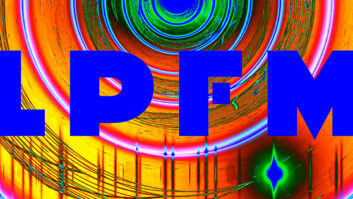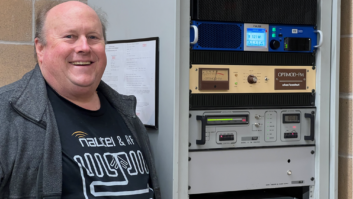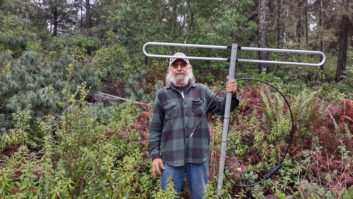
Fig. 1: ‘Classic’ Directional Filter Combining System
Increasing the IBOC digital sidebands from –20 dBc to as high as –10 dBc presents more challenges for broadcasters wanting to transmit from one antenna.
At –20 dBc, transmitting from one antenna requires digital and analog signals to be combined one of several ways: low-level or common amplification, high-level (couple digital power to transmission line at 10 dB), or mid-level, which uses a combination of common amplification and hybrid coupling to minimize FM and digital losses.
Common amplification is the most efficient and cost-effective way to combine FM and digital sidebands; however, with increased digital sidebands, it becomes difficult to use common amplification in a linear mode at powers above 20 kW due to peak voltages.
At the 2009 NAB Show in Las Vegas, Myat introduced a patent-pending technique for combining FM and digital sidebands for IBOC transmission to a single antenna. The system uses filters to combine digital sidebands operating in MP1 or MP3 more efficiently than high- and mid-level techniques, and is ideal for increased digital power.
The low-loss IBOC combining system utilizes the classic directional filter circuit shown in Fig. 1, and consists of two quadrature hybrids, two identically tuned filters and a reject load. The directional filter in Fig. 1 has been used for years to combine multi-station FM and TV signals to one transmission line while providing adequate isolation between transmitters.
COMBINER OPERATION AND LIMITATIONS
A signal at the narrow-band input port is split in quadrature (the split outputs have a 90 degree phase difference), passes through the bandpass filters, and is recombined at the output hybrid due to the phase relationship of the signals at the hybrid. Out-of-band signals delivered to the broadband input port will split in quadrature at the output hybrid, reflect off the bandpass filters (the amount reflected is a function of filter rejection), and be delivered back to the output hybrid where they are recombined and delivered to the output terminal.
(click thumbnail)
Fig. 2: Three-Section Filter Response, S21 and S11, 1.6 MHz and 800 kHz Channel Separation Isolation from broadband input to the narrow-band input port is a sum of filter rejection (typically 27–30 dB) and hybrid directionality (typically 36–45 dB). Isolation from the narrow-band input to the broadband input port is dependent on hybrid directionality, 36–45 dB, and proper phase matching of the bandpass filters. The transmission response from each input to the output is shown in Fig. 1 and color-coded. Note the transmission response for each input is similar to the S-parameters of the bandpass filter (i.e. the narrow input is the filter’s transmission response, S21, while the broadband input is the filter’s reflected response, S11 or S22). This makes analysis of the directional filter simple.
There is nothing new about the directional filter layout in Fig. 1 other than the type of filtering provided to perform the combining function of analog and digital signals for IBOC transmission. Illustrated in Fig. 2 is the typical frequency response (S21 and S11) of a three-section filter used for combining co-located FM channels with 1.6 MHz separation and the same filter with 800 kHz separation. Remember, the filter transmission response, S21 in red, represents the narrow-band input to output frequency response of the directional filter in Fig. 1. The filter return loss, S11 in blue, represents the frequency response of the broadband input to output. The limited rejection for 800 kHz spacing (approx. 7.5 dB at 600 kHz from filter center frequency, i.e. the lower band edge of channel to be combined) results in higher loss (approx. 1.2 dB at the lower band edge of channel to be combined) at the broadband input.


Fig. 3: Relationship Between Filter Rejection and Broadband Port Insertion Loss Module insertion loss from the broadband input port to the output port is plotted as a function of filter rejection in Fig. 3, and illustrates the need for high rejection to obtain low insertion loss from the broadband input to output port.
This is way too much loss for high-power FM combining. Transmitters don’t typically have the headroom to waste this much power; filters would run exceptionally hot and the low efficiency results in high operating costs. As a result, a four-section filter (or three sections with cross-coupling) that provides more rejection is required for 800 kHz channel separation.
UNSUITABLE FOR IBOC?
The use of filters to combine FM and digital sidebands was discussed early in the rollout of HD Radio, but quickly ignored due to the filter order required for 27–30 dB rejection at the digital sidebands, its related cost, size and resulting FM loss. Referring to Fig. 1, the analog or FM input is applied to the narrow input, and the digital signal applied to the broadband input. A six-section sharp-tuned filter with multiple cross-couplings can achieve the required rejection at the IBOC MP1 digital sidebands. Six-section pseudo-elliptic function filters that incorporate multiple cross couplings are not difficult to design; however, significant losses are incurred due to the narrow bandwidth and filter order (compared to “classic” tuned FM filters).

Fig. 4: Sharp-Tuned Pseudo-Elliptic Function Filter Response for Combining Digital Sidebands to Host FM Higher losses lower the power handling capabilities for a given size filter. A six-section, pseudo-elliptic function, sharp-tuned filter response and table summarizing loss results is illustrated in Fig. 4. The shaded red represents the host FM channel +/– 75 kHz while shaded blue represents the MP1 mode digital sidebands. Integrated or average loss of this narrow sharp-tuned filter using high Q 24 inch square cavities that provides 30 dB rejection at the digital sidebands is approximately 1.31 dB. Note however, that due to the finite cavity Q there is also significant loss roll-off at the digital sidebands inner edge. Using this size cavity in a classic four-section filter with wider bandwidth (400 kHz plus) would have approximately 0.25 dB loss and handle 30 kW. The sharp-tuned filter in Fig. 4 using same cavity geometry can only handle approximately 7 kW without a lot of additional cooling.
It’s easy to see why sharp-tuned filters were quickly discarded as a solution to combine FM and digital sidebands.
INTENTIONAL LOSSES
A directional filter combining solution that purposely exhibits loss was overlooked. Reducing filter order and requiring less rejection at the digital sidebands has less impact on the host FM (lower loss, lower delay and loss variation), and the digital loss incurred is significantly less than current high- and mid-level combining solutions. Fig. 5 illustrates one solution using a four-pole filter with a Chebyshev response. The shaded red represents the host FM channel +/– 75 kHz while shaded blue represents MP1 mode digital sidebands. Note the integrated loss and variations over FM (+/– 75 kHz) are significantly less than the sharp-tuned filter.

Fig. 5: ‘Mild’ Tuned Four-Section Filter Response for Combining Digital Sidebands to FM The loss numbers in Fig. 5 are calculated using the unloaded Qs of 24 inch square cavities. The higher loss as compared to a “classic” tuned four-section filter is due to the narrow bandwidth. For example, the bandwidth of the filter response in Fig. 5 is approximately 160 kHz, compared to 400 kHz minimum used in “classic” FM combining applications. Fig. 6 illustrates the effect of bandwidth on losses for a four-pole filter. Note a 400 kHz wide four-pole filter used in a “classic” combiner would have approximately 0.25 dB mid-band insertion loss.
Even with the reduced integrated loss (0.87 dB) the bandpass filters will still require significant cooling apparatus. Three section filters with cross-coupling provide a more optimum solution when considering loss and degradation to the host FM with only slightly higher integrated loss on the digital sidebands. Instead of bandpass filters, notch filters could also be used in the complementary circuit.
The directional combining solution that purposely exhibits loss does not require lossy and unreliable circulators for isolation. However, isolation is a function of filter rejection as described above, and is reduced compared to the isolations achieved in “classic” FM combining modules due to the reduced requirement for digital combining. Classic multi-station FM combining modules will have approximately 30 dB of rejection at the channel to be combined, and therefore, provide approximately 65 dB to 70 dB isolation when hybrid directionality is added. IBOC combining modules provide 40 dB–45 dB isolation between all ports, significantly less due to lower filter rejection.

Fig. 6: Mid-Band Filter Loss vs. Filter Bandwidth As presented at the 2009 NAB Show in Las Vegas, a four-pole combining module was tested using a Harris HPX Transmitter with a FlexStar HDx Exciter operating in analog mode at 24.1 kW applied to the narrow input of Fig. 1. A Harris Z16HD Transmitter using a FlexStar HDx Exciter at 2.7 kW was applied to the digital input, or broadband port of Fig. 1. The combined output of 20 kW FM with 2 kW (–10 dBc) digital sidebands is shown in Fig. 7, MP3 mode of operation.

Fig. 7: Combined Output, 20 kW Analog, 2 kW Digital There was moderate degradation to the FM signal without linear pre-correction. The uncorrected degradation to the FM signal was not severe enough to prevent this combining solution; however, linear correction can further reduce degradation. The 1.4 dB roll-off slope impressed by the filter on the inner MP1 (or the 7 dB slope impressed by the filter on the inner MP3) HD Radio sidebands had no impact on uncorrected Block Error Rate, introduced no change in the CD/No of 72.5 dB, and the signal was fully receivable on an external consumer receiver in both MP1 and MP3 modes. Combiner isolation was more than adequate to suppress RF IMD products to meet NRSC-5B emission mask requirements (see Fig. 7) without RF circulators or isolators.
The impact on HD Radio Modulation Error Ratio (MER), a new standardized method for determining transmission quality, needs further investigation. Myat is working with major radio groups and transmitter manufacturers to clarify complete proof of performance.
Although narrow sharp-tuned filters were initially discussed for IBOC combining, high cost, large size and excessive loss and loss variations prohibit their use. The combining system described here that uses wider, mild-tuned filters has less impact on the host FM and has significantly better digital efficiencies (see Fig. 5 for efficiency comparison) than other high-level combining techniques. The combining system is ideal for the early adopter wanting to increase digital power up to –10 dBc without the need to invest in another transmitter. The combiner also has application for higher-power stations (approximately 20 kW TPO and above) where common amplification is not practical because of the excessive peak voltage in the transmitter.
Derek J. Small is director of filter products for Myat Inc.
Comment on this or any other story at[email protected].












